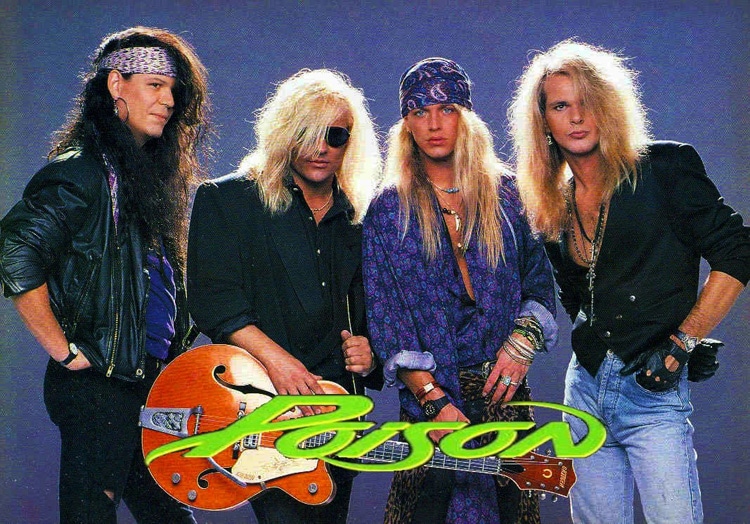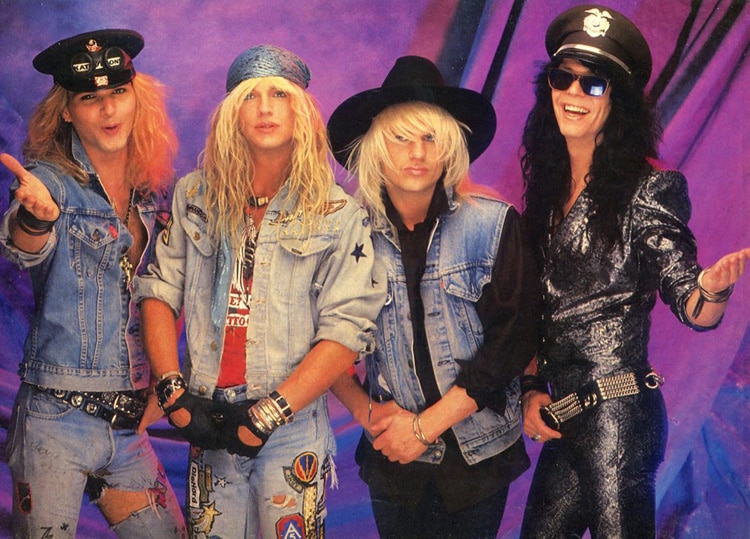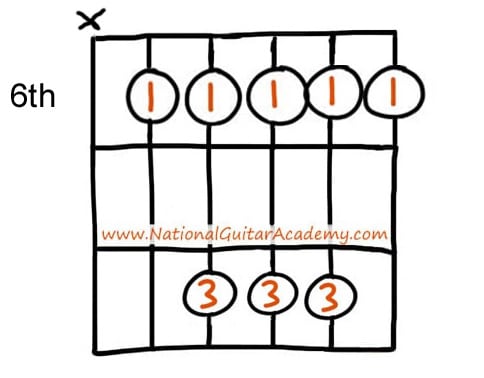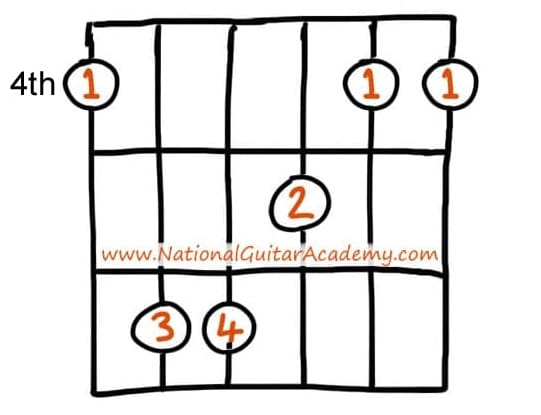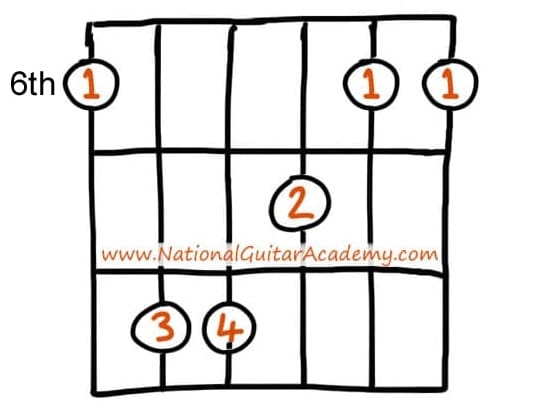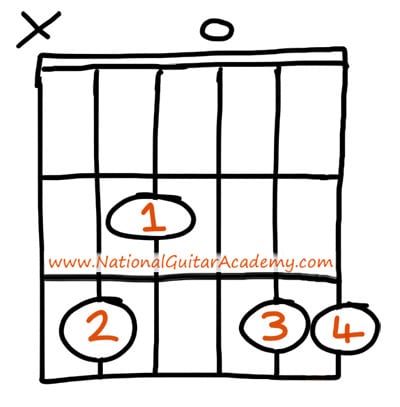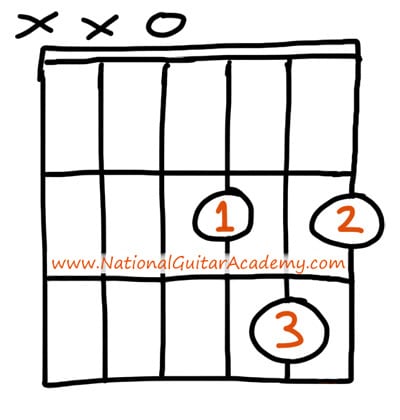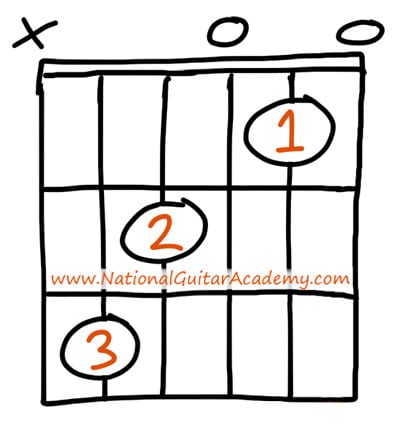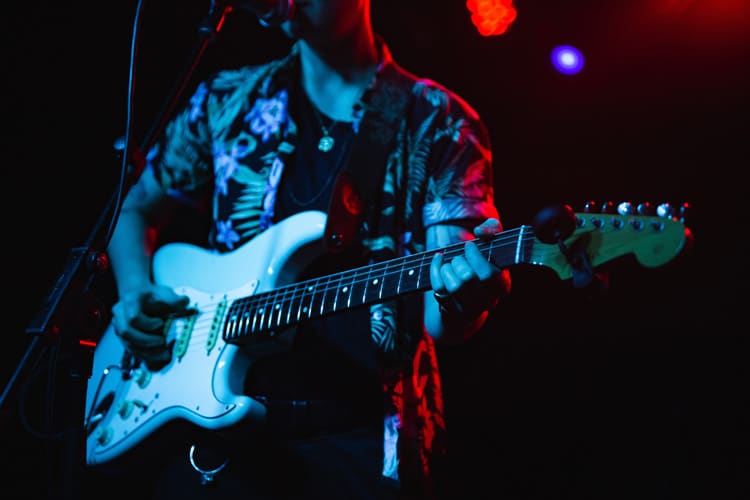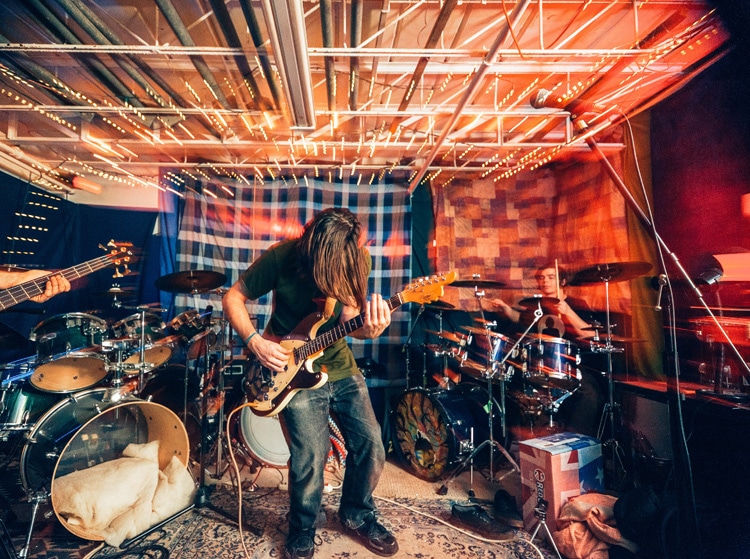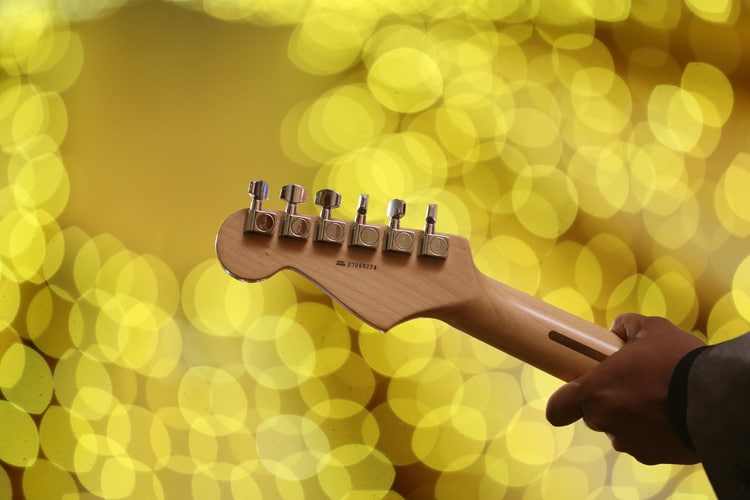In the mood for a hair metal ballad? We’ve got just the thing – let’s explore Poison’s Every Rose Has Its Thorn chords.
Over 100,000 guitar-learners get our world-class guitar tips & tutorials sent straight to their inbox:
Click here to join them
Get our best guitar tips & videos
In this free lesson you will learn…
- An easy way to break down songs for easier learning
- How to commit songs & chords to memory more easily
- How to pivot between chords
- How to play Every Rose Has Its Thorn by Poison
Poison’s Every Rose Has Its Thorn Chords Are Easy To Play
When we think of the hair metal bands of the 80’s, we usually think of a few things right away:
- Big hair
- Hairspray
- Tight pants
- Awesome guitar riffs
These are the obvious ones, sure, but there’s one more thing that comes with almost every hair metal band of the 1980’s:
Ballads.
That’s right folks – a slow, brooding song you can slow dance to and sing to the guy or girl you’ve been crushing on since high school.
Ballads became an unlikely staple in hair metal bands.
For a single song, the band would hang up all their attitude, slow down the tempo and serenade the audience in a way that would make you think just for a second that any one of them might be worth bringing home to meet your parents.
As funny as that might sound, it was a thing that many heavier bands did to garner themselves radio popularity, and it worked.
Poison was no exception to this marketing rule of thumb, and their unforgettable tune “Every Rose Has Its Thorn” skyrocketed their success in a big way.
The Every Rose Has Its Thorn chords are simple and easy, and we’re going to take you step-by-step through every aspect of the song today.
Click here to listen to the track.
Wait a minute – Before we begin!
This song is not tuned to standard tuning, although it might look like it from the chord shapes you’ll see. Poison tune their guitars one half-step down from standard tuning, so your strings should look like this:
Eb
(If you don't understand the above image please read our article "How To Read Guitar Chordboxes In 60 Seconds". It will make everything clear!)
Ab
Db
Gb
Bb
Learn 12 EASY beginner chords with our popular guide


Where should we send it?
✅ Stop struggling. Start making music.
✅ Learn beginner-friendly versions of every chord.
This is our most popular guide and it will improve your chord ability quickly! 😎
Get your own personalised guitar-learning plan 🎸
Get a custom guitar-learning plan here: Click here for GuitarMetrics™
World-Class Guitar Courses 🌎
Learn from the world's best guitar educators: Click here for our guitar courses
Every Rose Has Its Thorn Chords I – The First Two Chords
When it comes to learning songs, there’s a process that will always stand to push you further ahead, quicker:
- Learn the chords one-by-one
- Learn the strumming pattern
- Practice your chord transitions
- Learn the lyrics
- Put it all together
It can be easy to want to learn all the things about a song all at once, but it doesn’t get us far.
We’re going to practice this process today with this lesson on the Every Rose Has Its Thorn chords by first looking at the order in which the chords pop up.
The Every Rose Has Its Thorn chords are centered mostly around G major and Cadd9 for the bulk of the song, which gives us an amazing advantage toward learning it.
Where these two chords are concerned, you can simply leave your pinky and ring fingers on the B and high E strings at the third fret.
This will let you focus your energy on your index and middle fingers, who will have to switch back and forth between string groups to accommodate each chord.
Let’s start by practicing the motion back and forth between these two chords:
G MAJOR
C ADD9
Every Rose Has Its Thorn Chords II – Completing the Progressions
We’ve only got three other chords we need to master in order to be able to play all of the chords in this song.
Easy, right? Fairly. The other Every Rose Has Its Thorn chords are ones you might already know.
After the initial back and forth of G major and C add9 for the first three stanzas, we see a D major chord pop up at the beginning of the last line of the verse (“though I tried not to hurt you…”).
This one is easy enough to take care of (see the diagram below), but we’re faced with a C major chord immediately afterward. This transition is worth taking some time on.
D MAJOR
When you move out of D major, lead with your ring finger down to the A string on the 3rd fret and allow that to help you set up the rest of the C major chord.
Pro Tip: Many times, leading a chord transition with the finger that takes the lowest note of the next chord can help set you up for success much more easily.
Before we move into the next section of the Every Rose Has Its Thorn chords, it’s a good idea to give these four chord transitions some practice altogether.
Let’s take a few minutes to rehearse our transitions from:
- G major to Cadd9
- Cadd9 to D major
- D major to C major
- C major to G major
To start with, strum each of the Every Rose Has Its Thorn chords and hold for a count of “1-2-3-4” before switching to the next chord.
It’s worth noting that we see an E minor chord pop up later on in the bridge, so take a bit of time to get that one under your fingers as well if you haven’t already.
C MAJOR
E MINOR
Every Rose Has Its Thorn Chords III – The First Strumming Pattern
Now that we’ve mastered the chords we need to play this whole song, we can move on to the rhythm.
Rhythm is how we carry the groove of the song, and so it’s important to pay attention to how the song flows.
Remember: Guitar isn’t just about the chords you play, it’s about everything put together. You can play some wonderfully defined chords, but they need to have rhythm behind them in order to go somewhere.
Thankfully, the strumming pattern that accompanies the front-end of the Every Rose Has Its Thorn chords is super-straightforward.
We’re going to count in 8th notes for this chord progression, and it looks like this:
Why do we count this way?
8th notes leave room for stressed and non-stressed strums to ring out, giving us plenty of room to learn the strumming pattern.
The strumming pattern for the intro and first verse of the Every Rose Has Its Thorn chords goes like this (with the count):
D D D U U D D U U
1 & 2 & 3 & 4 &
Did you see how some of the strums land in between the beats?
This is an important concept that we can master easily with some practice – keep reading to find out how.
Try This: Counting in 8th notes like we have above, take a G major chord and strum down for every number you count, and up for every & that you count. This should give you a consistent down-up pattern.
From there, strum only on the downbeats (1, 2, 3, 4) – then only on the upbeats (&).
Finally, try strumming in between the beats to get a feel for how playing between the beats works.
As you can see, this is a technique we need to employ to play through the Every Rose Has Its Thorn Chords effectively, so give this exercise a good shot!
Every Rose Has Its Thorn Chords IV – The Second Strumming Pattern
First and foremost, if you’re a beginner there’s one thing we should clear up:
You don’t necessarily need to play this second strumming pattern to effectively play the Every Rose Has Its Thorn chords, but it helps to put a variation in your back pocket regardless.
If you’re feeling like smashing some goals, keep reading to learn the second pattern.
The first strumming pattern for these chords gave us some room to play in between the beats, and this pattern does the same.
You’ll hear the following pattern prominently in the 2nd verse, choruses, bridge and solo sections.
D D D U U D D D U U
1 & 2 & 3 & 4 &
Although only slightly different than the first strumming pattern, this pattern puts a little bit more push in our Every Rose Has Its Thorn chords which serves to drive the song a little harder – not a bad thing at all!
Before we move into the next section, take some time to practice your chords that you’ve learned so far with these two strumming patterns. Check out the diagrams below:
G MAJOR
CADD9
D MAJOR
C MAJOR
E MINOR
Every Rose Has Its Thorn Chords V – Practicing Chord Transitions
Okay, so this is where it gets fun and where we start to put things together.
This might seem like we’re rambling on about the fine details of the Every Rose Has Its Thorn chords, but deconstructing a song in this way really is the most effective way for us to learn about all its moving parts.
The more we learn, the better we play. Period.
As we discussed above, moving from G major to Cadd9 isn’t that big of a deal, but we can hash a few more details out with the other ones.
Try moving from Cadd9 to D major first.
CADD9
D MAJOR
C MAJOR
E MINOR
When we position our fingers in the shape of Cadd9, our ring finger should be on the 3rd fret of the B string.
We can keep that finger in that same position as we move to play D major.
This is commonly known as pivoting – where you use one common finger between two chords to pivot from one to the next with increased stability. You’ll see this technique pop up a bit between the Every Rose Has Its Thorn chords you’ve learned.
Pro Tip: Pivoting isn’t always an available option to move between two chords, but it’s a good idea to look out for commonalities between chords to use it when possible.
As we said above, we can use our ring finger to lead us from D major to C major, setting up the rest of the chord simply by working backwards.
D MAJOR
C MAJOR
C major and E minor are another two Every Rose Has Its Thorn chords that we can pivot between, this time using our middle finger as the pivot finger instead.
Now that we’ve mastered the chords, strumming patterns and chord transitions, we can begin to put it all together and turn this progression into a song!
C MAJOR
E MINOR
Download our lead guitar cheat-sheet to make things easier
It's hard to understand which scales work with which keys.
So we created a cheat-sheet! A key and scale-finder that you can use again and again.
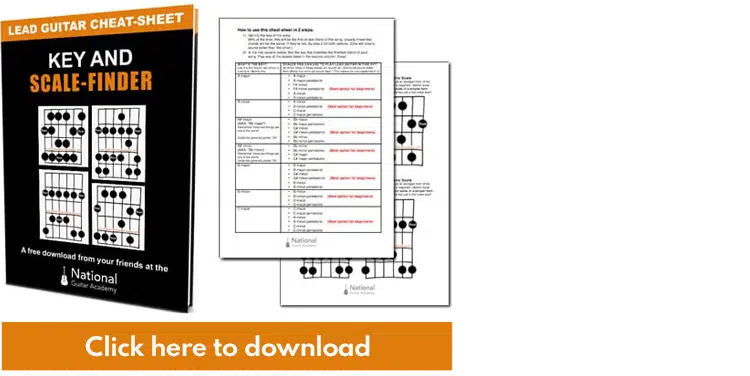
Get your personalised guitar-learning plan 🎸
Get a custom guitar-learning plan here: Click here for GuitarMetrics™
World-Class Guitar Courses 🌎
Learn from the world's best guitar educators: Click here for our guitar courses
Every Rose Has Its Thorn Chords V – Four Sections/Four Progressions
As we’ve said, most of the bulk of this song relies on the interplay between G major and C add9, but we’re going to lay out the chord progressions of each section for you so you’ve got all your goalposts sorted for this song.
Remember: Practice each chord progression individually before you attack the whole song – you’ll spend less time going back and forth on chord formations and more time feeling like a rockstar.
As with every song, learn to master the Every Rose Has Its Thorn chords individually as well and you won’t miss.
Intro & Verses:
G major & Cadd9
End of Verse 1 (“Though I tried not to hurt you…”):
D major & C major
Chorus (laid out with lyrics for reference):
G Cadd9
Every rose has its thorn.
G Cadd9
Just like every night has its dawn.
G D C G
Just like every cowboy sings a sad, sad song.
G C
Every rose has its thorn.
Pro Tip: Notice the placement of the Every Rose Has Its Thorn chords over specific words in each line? It’s important to take note of this so we can accurately measure the amount of time needed between chords.
Bridge:
(4 beats per chord evenly)
E minor – D major – C major – G major
E minor – D major – C major
Solo Section:
G major – Cadd9 – G major – Cadd9
Eminor – D major – C major – G major
Eminor – D major – C major – C major
G major – Cadd9 – G major – Cadd9
Pro Tip: If you want to be really clever about learning the Every Rose Has Its Thorn chords, play the track back and strum once per chord as the song plays while you count 8th notes like we have above.
This will help increase your time feel, as well as your sense of rhythm on the whole.
Once you’ve done this a few times, start working in the strumming pattern!
Putting It All Together
Want to know the best way to master any tune?
Practice repeatedly and sing along!
Repeated practice helps us internalize the chord progression, while singing along will help us place the chords in their appropriate spots a lot more easily.
Throughout this lesson we’ve tried to break everything down into small steps that will not only help you master the Every Rose Has Its Thorn chords, but master the formula for practicing new music as well.
The more we learn about a song’s individual parts, the easier it is to learn it as a whole.
Remember: Every song is just a series of moving parts, and as we master each of them the bigger picture of the song itself becomes clearer.
Want More Out Of Your Every Rose Has Its Thorn Chords?
These same chords are used in a massive amount of other songs.
While it’s great to learn them just for this song, it’s a good idea to take some time each day to practice these chords separately as well. The more songs you learn, the more you’ll realize just how common these chords are in popular music.
Practice will take you farther than anything else, so make sure to keep picking up that guitar!
Recommended Resources
If you enjoyed this lesson, you’ll be happy to know that there’s plenty more to choose from.
Take a look at some of the awesome lessons we’ve got for you below:
- How To Play ‘Riptide’ by Vance Joy
- Easy Beatles’ Songs on Guitar
- How To Sing & Play Guitar At The Same Time
- How To Read Guitar Chordboxes
- An Essential Guide To Guitar Keys
What Type of Guitarist Are You?
Take our 60-second quiz & get your results: Take The Quiz
Join the world's best online guitar school 🌎
- Get your own personalised guitar learning plan (customised just for YOU).
- World-class online guitar courses. Learn at your own pace.
- Community Campus & Learning Forum - A friendly community! Connect with our team & students. 😊
- Beginner Song library with chordsheets, tabs and tips. (Songs suitable for all levels!)
- Regular live streams, seminars and Q&A sessions - Learn from world-class guitar educators. Get all your questions answered!
Click here to learn more about National Guitar Academy membership 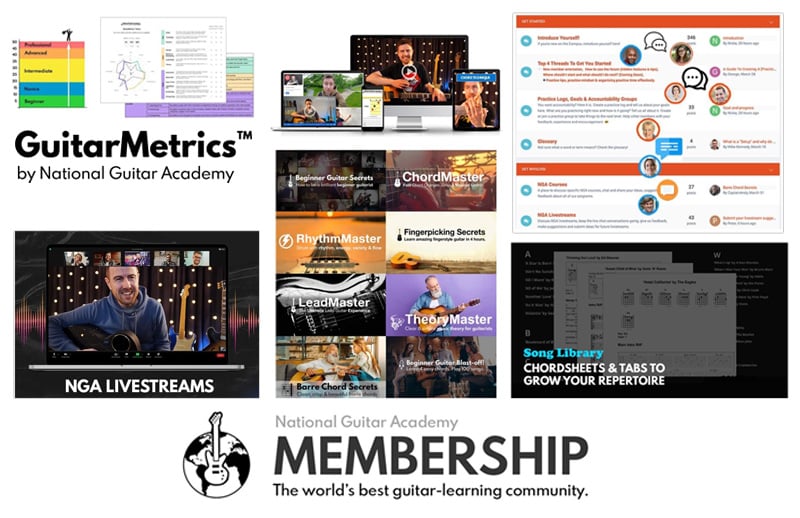
Cool Guitar T-shirts 😎
Look cooler! Check out our merch: Click here to see our merch store
Want free guitar tips and video lessons delivered to your inbox?
Join over 100,000 guitar-learners and subscribe to our guitar-tips-by-email service. (It's free.)
We'll send you a series of lessons that will move you to the next level of your guitar journey.
Learn how everything fits together quickly, easily and effectively. We share ninja tips (for instant fun!) but also timeless fundamentals that will deepen your understanding.


Get our best guitar tips & videos
Popular Lessons
How To Learn Guitar: An 11-Step Programme For Beginners
How To Choose The Perfect Beginner Guitar
More Cool Guitar Stuff
Learn about National Guitar Academy: About Us
Join us on Facebook for daily guitar tips.
Listen to our Learn Guitar Podcast for rapid guitar progress.
Check out our free chord lessons.


